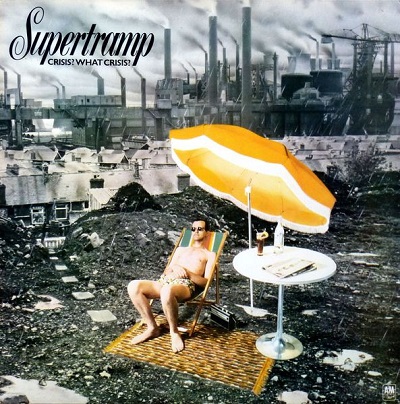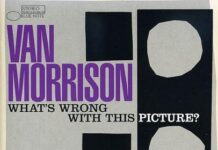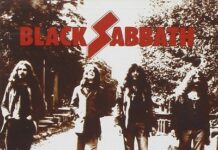Supertramp’s Crisis? What Crisis? rates right up there for me with their mega 1979 hit Breakfast In America. I know that comparison might not be so very logical — sorry — still, this fourth album by the band is among their very best. It also sports what is considered one of the very best covers of any 1970 rock album. And in an era that saw so many iconic rock album covers, that’s one hell of a compliment, to be sure.
Coming off Supertramp’s first, and much needed for them, real success with Crime Of The Century released the year before, the quintet released C?WC? in September of 1975, to a surprisingly lukewarm reception. As has often been the case, the sandwiching of one album between hit albums—Crisis? What Crisis? comes between Crime Of The Century and the band’s 1977 Even In The Quietest Moments — often relegates an album like this, even as strong as it is, to lesser popularity. It could also be the fact that recording this record in America, in L.A., specifically, brought a different mood to Supertramp’s output; Rick Davies, one of the band’s principal songwriters, vocalists and keyboardist, has mentioned that unlike with Crime Of The Century, Crisis? What Crisis? lacks a “global concept.”
Just to be clear, though, Crisis? What Crisis? made it into the Top 20 in the UK and skirted just outside the Top 40 in America and we get the classic line-up of the band here: Roger Hodgson playing various guitars and keyboards, singing lead and one of the pair of stellar Tramp songwriters; Dougie Thomson playing bass; John Anthony Helliwell singing backing vocals and playing various woodwind instruments; Bob Siebenberg, (the only American in the band), playing percussion, and the other songwriter/leader of Supertramp, the ‘lower’-voiced Rick Davies, all playing, producing and writing at the top of their game. This is also an album where we can consider, yet again, ‘The Tramps’ more proggy sensibilities.
“Easy Does It” starts us off with some whistling feeding into an electric sitar, and plucky single-key notes. It’s a breezy little Hodgson number, informed by his high-warble and positive lyric. “Sister Moonshine” follows, a 12-string acoustic pushing things along, with the first airing of some outstanding floor tom work by Siebenberg (an underrated drummer if there ever was one), and those luscious Supertramp harmonies we are so used to.
Hodgson, always a most imaginative of lead players, lands some almost surf guitar noodles here, and Davies slips in some harmonica. It ends up being a thick Supertramp brew. Funk staccato piano and Thomson’s bass roll-off inform one of the better songs for me here, the following, “Ain’t Nobody But Me.” We get the first stab of Helliwell’s sax, and the band really rockin.’ I always have loved this tune, Davies’ piano playing especially.
“Soapbox Opera” presents Supertramp exposing the full range of their playing and composing. Synth strings, harmonies, high dramatic production stabs of both recorded speeches and a children’s choir added in; here’s a tune where things get decidedly proggy. All rendered in five minutes, the ability to create a solid piece of prog-rock in the short form is not to be taken lightly. Supertramp manages to do so on the short masterpiece in “Soapbox Opera.” Davies’ “Another Man’s Woman,” the weakest song on this side and one of the two weakest songs in general here, closes side A.
Side B opens with the first single released from Crisis? What Crisis? “Lady.” Organ and piano dance for dominance across the damn strong little commercial ditty. Davies’ electric piano and vocal squawking begin “Poor Boy,” the next tune, and like “Another Man’s Woman,” another not-so-great showing. But the middle songs on this side, the Davies/Hodson collaboration, “Just A Normal Day,” and then Hodson’s “The Meaning,” are true Supertramp classics.
Thomson is up nice and high in the mix on both, so one catches his subtle bass playing loud and clear. Davies and Hodson give their best-shared vocal on “Just A Normal Day,” and Davies his most plaintive on “The Meaning.” Helliwell provides perfect horn leads for the pair of tunes; sweet on “Just A Normal Day,” rocking and rising during the ending jam on “The Meaning.” These two songs, plus “Sister Moonshine” and even the more commercial “Ain’t Nobody But Me,” truly show what Supertramp would grow into.
As it began with Hodson’s light touch, this album ends with his “Two Of Us.” This could be taken either as a love song or a call out to his fellow bandmate and songwriter. The shorter version of this song that appears on the band’s live Paris double album set makes more of an impact for me. Here it just plays out a little too long with the keys a bit overdone. Still, it’s a pretty song about the convergence of shared approaches. Crisis? What Crisis? is a wonderful listen. Save for a couple of merely ok tunes, here is as solid an album as any of the others this band managed with their most popular lineup.
~ Ralph Greco, Jr.




















